Article
The Ultimate Guide to Crested Geckos
From their flirty long eyelashes to their wide expressive eyes and funny sticky toe pads used for climbing, crested geckos are definitely head-turners in pet shops. These reptile pets are not only attractive but also gentle and sociable, making them an excellent choice for first-time pet shoppers. As a bonus, they're petite, making them ideal for apartment dwellers or those without space for a large terrarium.
Here's what you'll learn about crested geckos:
A Brief History and Origin of the Crested Gecko
How Long Do Crested Geckos Live?
Why Crested Geckos Make Good Pets
Setting Up the Ideal Tank for a Crested Gecko
What Do Crested Geckos Eat?
How Do I Play with a Crested Gecko?
Ongoing Care Tips for Crested Geckos
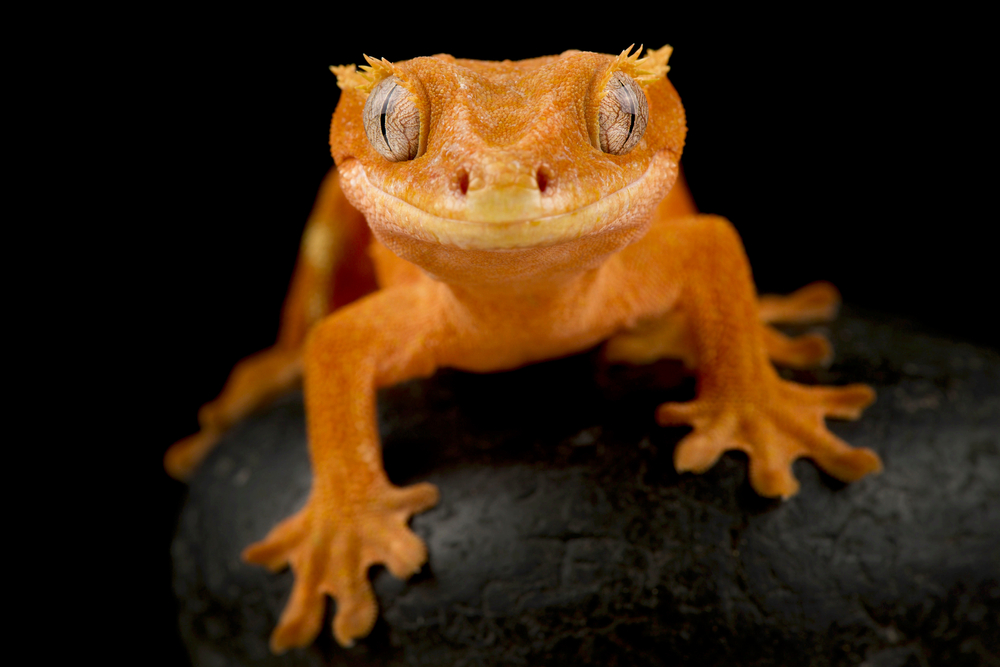
Crested geckos are originally from New Caledonia, a group of tropical islands in the South Pacific Ocean off the east coast of Australia. Once assumed extinct, the geckos were rediscovered in 1994 and soon after legally exported and introduced to the pet industry. Now, you can see them up close in pet stores across the globe!
In the wild, you'll find crested geckos hanging out in short trees and bushy foliage in the forest. These nocturnal animals like to stay tucked away to camouflage into the environment as they sleep away the days and hunt for food at night. When you do see a crested gecko out and about, you'll delight in its colorful skin featuring various patterns and shades of red, browns, greens, and other earth-tone hues. Cresteds are known as "polymorphic" or have many mutations in their appearance. Bottom line: No two cresties look exactly the same.
So, why are they called crested geckos? Look closely at their heads, and you'll see two ridges, or crests, running from just behind their eyes towards their necks, where the crests merge and create a ridge down the back. This unique trait has become their clever namesake. You might also think they could be called mini-mohawk geckos, but crested sounds a bit better!
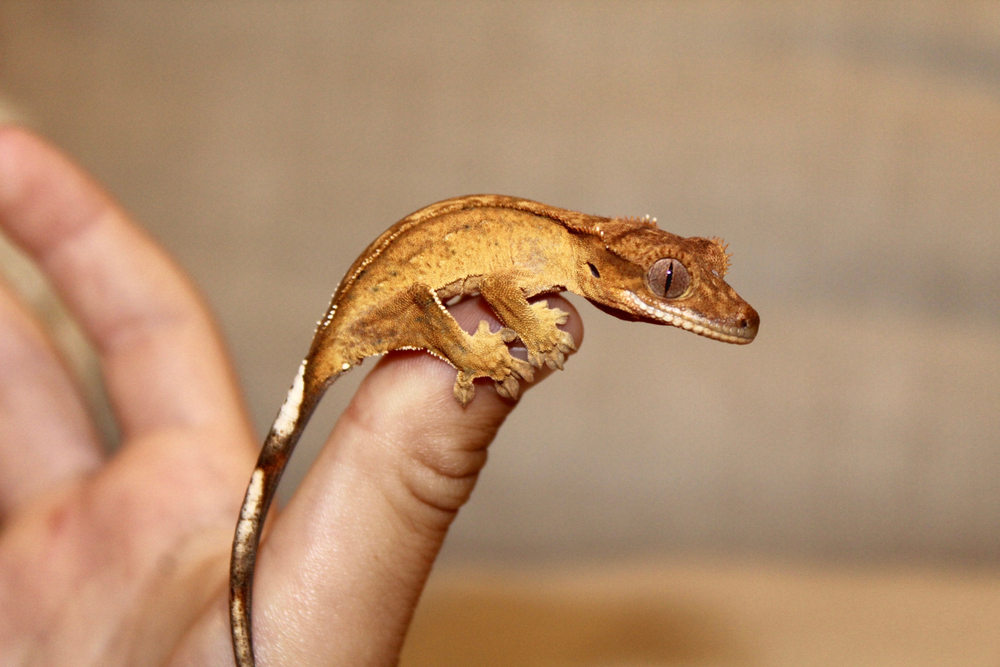
Crested geckos are hardy little reptile pets that can live up to 20 years. That's longer than the average family cat or dog, so be sure you're up for the commitment.
A crested gecko truly is a family pet where everyone in the household should understand what these little guys need to stay happy and healthy. If the gecko is your child's pet, be ready to take over the animal's care duties when the child gets involved in school activities or goes off to college.
.jpg?h=67%25&w=100%25&hash=A76E7AF759886708D912CDB37BB30B45)
Their small size makes cresteds a top choice on many best reptile pet lists. When adults, the animal's full length (tail and all!) are a mere 8 to 10 inches. This means they are easy to handle and don't require a large habitat to be comfortable in your home.
These guys are also very docile and friendly. They're unlikely to bite unless provoked or when feeling scared. Cresties make great pets for supervised, older children and responsible teenagers who want to learn more about reptiles and see them up close.
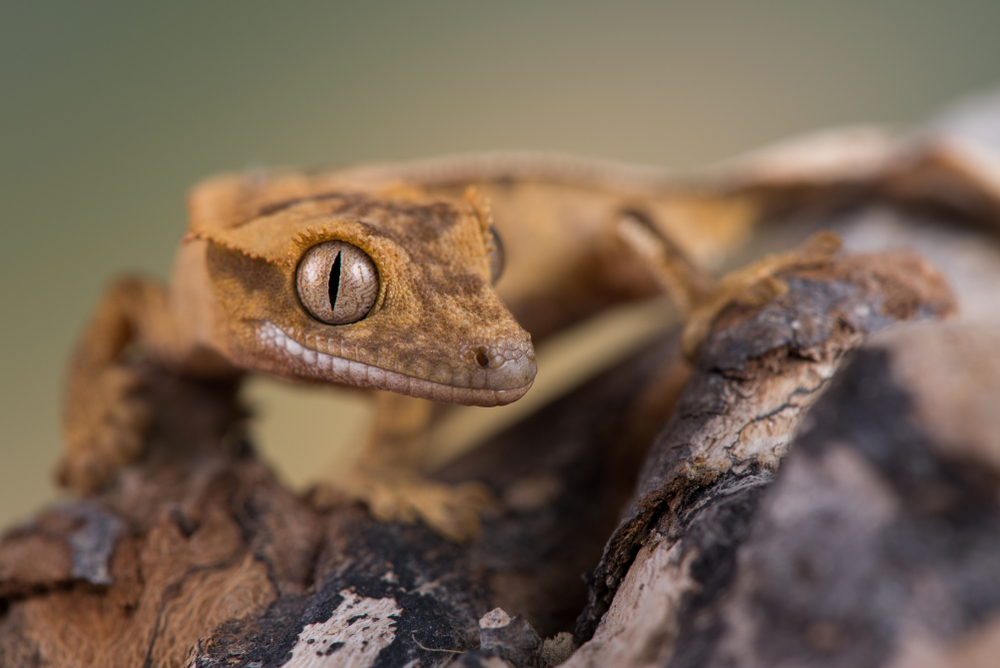
Be sure your crested gecko's habitat is set up and ready to go before you bring the pet home. We've got a few tips on choosing the tank, heating and lighting, decor, bedding, and food options.
If you adopt a baby crested gecko, a smaller 10-gallon tank will work just fine. However, if you bring home an adult or only want to buy one habitat your pet can grow into, look at a 20-gallon enclosure or larger. (Remember that for cresties, height is more important than ground space, so go taller rather than longer.) Be sure it has a locking screen lid because cresties are curious and will nudge at the top to climb even higher — up and out of the tank if allowed!
Check out the Zilla Tropical Vertical Kit that measures 12" x 12" x 18". Since crested geckos are arboreal (aka tree dwellers), the vertical nature of this habitat allows the pet to climb, climb, climb. Plus, there's a locking latch and locking pin on the enclosure's front door to keep your pet safe. This kit also includes lots of accessories, such as a feeding dish, coconut husk bedding to get started, and a humidity/temperature gauge.
Crested geckos — just like all cold-blooded reptiles — need accessory lighting and heating to help replicate their native environments, regulate day/night cycles, and promote proper digestion. Browse the Zilla Habitat Guide and the new Ultimate Guide to Lighting & Heating for specific details regarding heating and lighting for a variety of reptile pets.
As you set up the crestie's tank, use heat bulbs that will keep the home's temperature around 72-75°F. Some reptile experts warn that cresties can overheat easily, and exposure to temps over 80°F for too long can be fatal. Carefully experiment with your pet to learn what temperature allows for the most activity and happiness. For a good starting point, begin with the temperature the pet was enjoying in his previous pet store home.
Unlike most reptile pets, crested geckos do not need special lighting, such as UVA or UVB bulbs. This is because they are nocturnal, and hunt and play in the dark — not light. However, you can use the Zilla Canopy Series Tropical bulb for light to see your pet at night. The UVB bulb won't hurt your crested. You can use also a blue moon LED light or night red bulb to view your crested during their active night hours.
Crested geckos are tropical and need high humidity to stay comfortable. Use a mister or humidifier to increase the moisture of the air to a minimum of 50% and a maximum of a sticky 70-80% humidity. (Note: It's OK if they dry out between mistings. Geckos don't need to be perpetually wet!)
If you keep your house cooler (in the 50s) in the winter or when you're not at home, try using a Zilla Heat Mat to add extra warmth. You could also consider the placement of the habitat. Move it to an interior room in your home, away from cold walls, drafty windows, or exterior doors.
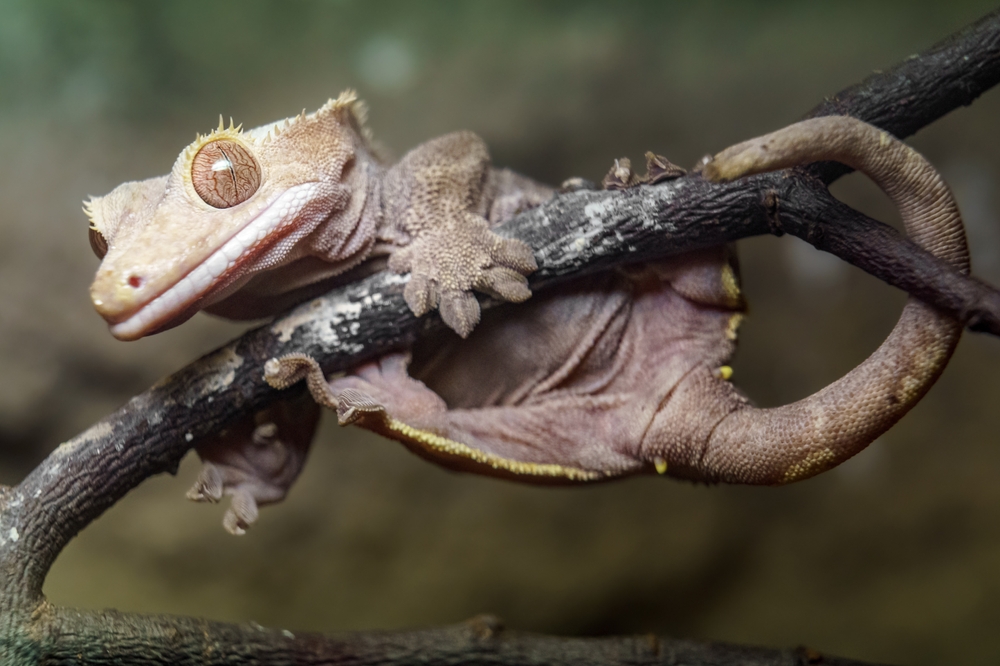
It might be tempting to buy your crested gecko a same-species friend, the ultimate in decor! This is a great idea as long as you only have one male gecko in the bunch to reduce the chances of fighting. You can easily tell if a crested is male or female by looking at its underside. A male has two bulges under the skin at the base of the tail. This area is flat and smooth on females.
The more friends you add, the bigger your tank should be so they all have enough room to spread out and play. For example, a tank with two crested geckos should measure at least 23" x 16" x 15".
Pro Tip: Never mix various reptile species in one tank. This can trigger fighting and injuries.
Beyond friends, deck the tank out with ample tree branches and foliage to replicate the tree environment these cuties love to explore. Choose store-bought branches of varying widths to exercise the gecko's grip. Use a variety of faux plants with various leaf shapes and sizes to nudge and poke around. These features will keep the pet entertained!
Pro Tip: It's best if you leave those branches from your last hike in the forest, no matter how cool they look. You might accidentally introduce parasites or creepy crawlies into the habitat that could make your crested sick.
Cresties also like to have a few hiding spots in their home. These places keep them cool and allow some private rest time. Pick out a Bark Bends log or driftwood with a hole bored in it to serve as a little hideaway den.
On the bottom of your crested gecko's tank, you'll want a little something to absorb waste and odors. Plus, it can amplify the look of the forest-themed tank. We call this bedding or substrate.
For tropical geckos, consider Zilla Bark Blend, Coconut Husk, or Jungle Mix. These most closely replicate the animal's natural native forest environment. You can review the Zilla Bedding Guide for more ideas too.
The Terrarium Liners from Zilla also work great for crested geckos. It's a no-pile carpet that's easily cut to fit the bottom of the enclosure. It's treated with a biodegradable enzyme that helps keep odors to a minimum. Simply wash, dry, and reuse the liner when it's time to clean your pet's home. (You can also use plain paper towels, which are easy to replace.)
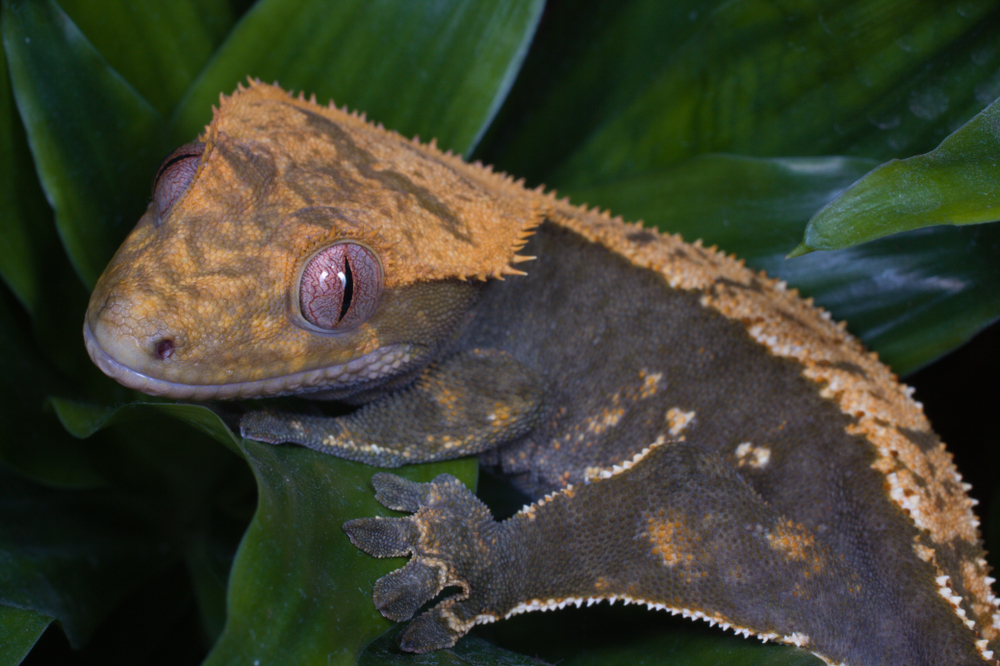
Plan to tidy up your crested gecko's tank each day. This means picking up obvious waste or uneaten food to keep the home from getting stinky. You can use a scoop to keep this task super easy.
Deep clean the enclosure every two or three months to make sure the walls sparkle so you can easily see your dino buddy:
Step 1: Remove your pet.
This is a good time for the pet to enjoy playtime with a family member or friend. Or, the pet can hang out in a large Zilla Micro Habitat to stay safe. Be sure to use the locking mechanism at the top if you don't want to go on a gecko hunt later.
Step 2: Turn off and unplug the lighting fixture.
Unplug any heat mats or other warming elements. Set them aside to cool off on a durable surface, such as a tile floor or stone countertop.
Step 3: Remove all decor.
Place the decor in a sink filled with hot water and a squirt of dish soap. Use a scrub brush to clean the items. Then, rinse the decor in a sink filled with a 10% bleach water solution. That's about 1 cup of bleach for a half-filled average-size sink basin. Rinse the decor with clear water and allow it to dry on a towel.
Step 4: Remove the bedding from the habitat.
Use the Zilla Corner Scoop to remove the bedding and place the soiled bedding in the waste can or compost bin. If you use a substrate liner, wash it with the decor in the step above.
Step 5: Wipe down the empty habitat.
Use a sponge soaked with hot water and dish soap. Be sure to remove lingering debris in the corners and stuck to the walls of the tank. Then, rinse with clean water using a sprayer attachment on your sink or a clean sponge. Finally, towel dry the habitat or allow it to air dry.
Step 6: Clean the habitat.
Once the clean habitat is dry, use the Zilla Terrarium Cleaner. This spray will add shine to the glass or acrylic surfaces, deodorize the habitat, and create an anti-static barrier to reduce dust build-up from the bedding. Simply spray on the clear surfaces of the habitat, then wipe off using a soft towel. Place the habitat back where it usually sits.
Step 7: Add new bedding and arrange the freshened decor.
This is your chance to mix things up and place the climbing branches and foliage in new positions for your pet to explore. Think of it like rearranging a kid's bedroom to add new interest and excitement.
Step 8: Replace the lighting fixture and any heating elements.
Plug them in and let the home get warm before you put your pet back inside. This may take up to 20 minutes or so. Use a digital thermometer to test the tank temperature and ensure it's ready for your tiny dino.
Step 9: Return your crested gecko back to his habitat.
Enjoy watching him explore his clean home. And don't forget to lock the enclosure, so your pet doesn't wander away to climb the curtains!
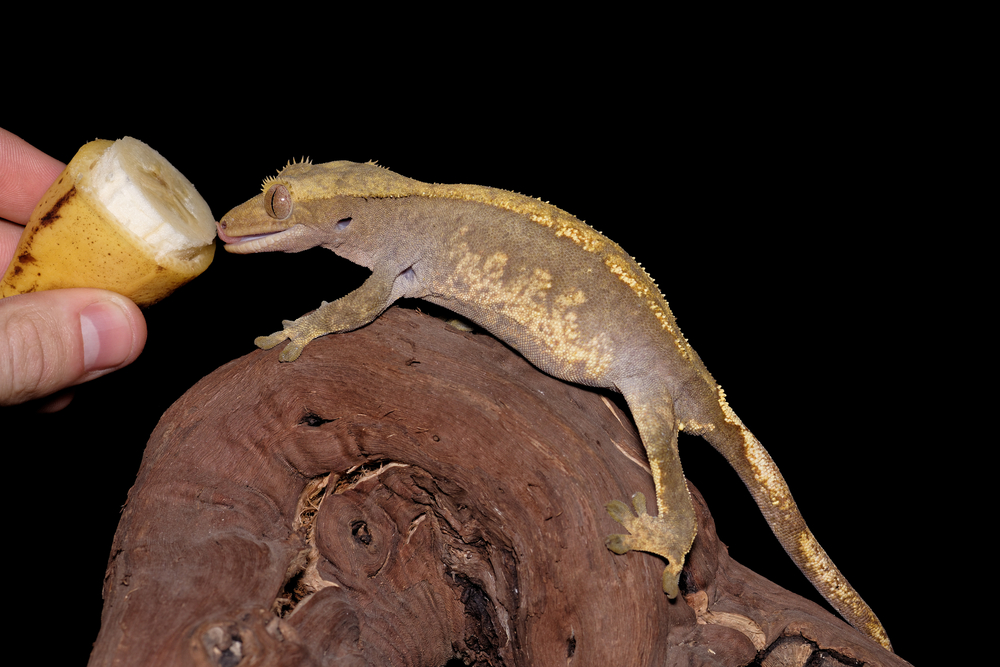
In the wild, crested geckos spend their evenings hunting for rotting fruits and unsuspecting insects to create a balanced diet.
When kept as pets, these omnivores enjoy eating live crickets no larger than the distance between the pet's nose to eye. This helps prevent choking. To boost the nutritional value of live foods, offer the insects Zilla Gut Load Cricket Drink before feeding your crested gecko. Then, at mealtime, spray the insects with Zilla Vitamin Supplement to aid calcium metabolism and Calcium Supplement to support bone health.
In addition to insects, serve up a commercially prepared crested gecko diet balanced with essential proteins, vitamins, and minerals. Try the Gecko Gold Powdered Diet featuring banana, apple, and mango. It easily mixes with water to form a soft mash your gecko will lick up with delight.
If you want to work on bonding with your pet, offer a hand-fed snack, like a peeled extra-ripe banana. We dare you not to giggle at the gecko's pink tongue tasting the sweet fruit!
Plan to feed your pet a meal two to three times each week or approximately every other day. (And don't forget to clean out uneaten food no more than 24 hours later.)
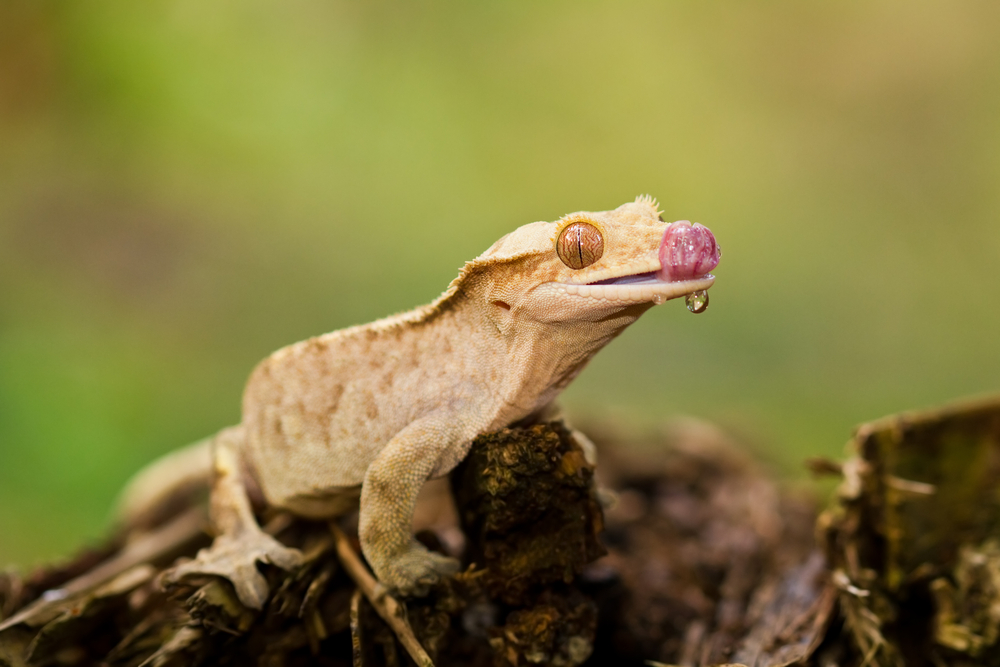
Crested geckos need access to fresh water at all times. Fill a shallow terrarium dish and mist water around the habitat once a day.
What's the best water to use? Choose ionized micro-clustered water filled with antioxidants and minerals poured from a water ionizer attached to your tap. Or, you can use tap water filtered through charcoal to remove the chlorine.
Avoid reverse osmosis water or distilled water since the beneficial mineral content is removed.
Check out the Zilla Feeding Guide for more information on feeding reptile pets.
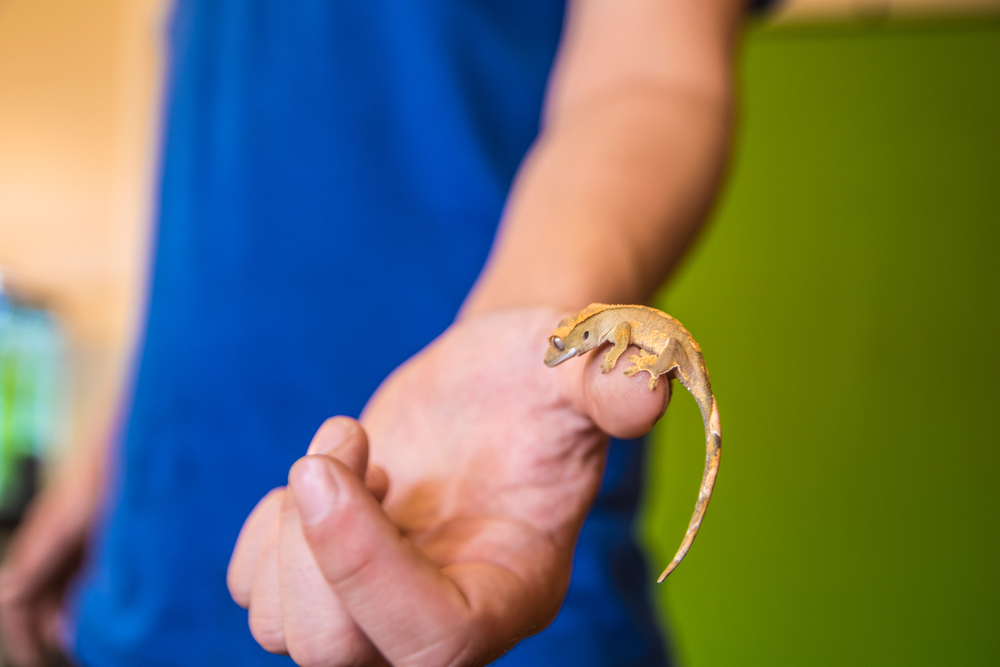
When handling your crested gecko, sit down and get cozy. It's best to have a soft touch and move slowly with a crestie. Let them crawl on your hands or up your sleeve to your shoulder.
You can create a game of hand-over-hand, also known as "hand walking," letting them run from one palm to your other palm. Then, line the first hand up again, palm to palm, so they can keep exploring. Just remember to move slowly.
If crested geckos feel spooked or threatened, they will detach their tail (called caudal autotomy) and run off. This is completely normal. You may see several cresteds in a pet store without their tail! The wiggly tail acts as a distraction while the gecko escapes predators or scary situations. If your pet's tail does snap off, it will not grow back. And a vet visit isn't needed. The area will heal over quickly, and your new pet will earn the nickname "Stubby." To avoid this type of situation, move slowly around the pet and keep "predators" such as the family cat or dog away from the habitat.
Pro Tip: To reduce the risk of spreading illness, wash your hands before and after handling any pet, including a crested gecko.
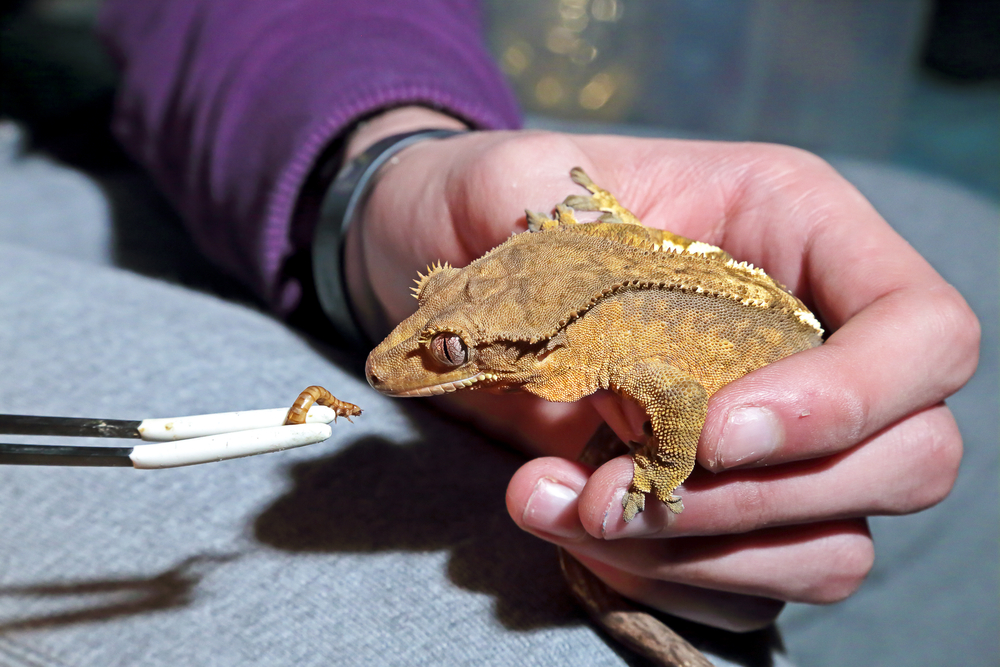
Crested geckos require daily care to stay healthy. This includes taking note of any physical changes or shifts in behavior that may indicate illness or disease, assisting with shedding, and allowing the pet to bathe as needed. Keeping a journal (major inspo here) regarding your pet's weight, feeding habits, and general health is not only a good way to bond with extra interactions, but also ensures your crested stays in tip-top shape. As you care for your crested gecko, never hesitate to call your exotics veterinarian with questions.
One of the common issues you may see in your crestie is in their mouth. Pay attention to the membranes around the mouth. If they become red or inflamed, contact your veterinarian for treatment options.
It's important to keep the humidity and temperature levels consistent to help maintain easy breathing for your pet in the terrarium. If you notice your lizard isn't breathing normally, contact your veterinarian.
Crested geckos may also experience problems with shedding, dehydration, parasitic infections, and skin rashes. These are all easily treated by a veterinarian.
Shedding
Crested geckos will shed their skin periodically as they grow. Sometimes called molting or sloughing, this is natural and healthy for them. Think of it like buying your growing toddler a new set of pajamas when they've outgrown the old pair. The shedding process also eliminates any parasites hanging out on the gecko's skin.
Baby crested geckos will usually shed weekly. As they get older, shedding decreases to every two weeks. Expect to see a shed every few weeks to every month when they're adults.
When a crested gecko is about to shed, the old skin will appear tight and duller in color. Then it will turn white and flake away, sometimes in large patches. Shedding happens fast. When the crestie outgrows the skin, it will loosen and peel or flake away in about 20 minutes. The pet generally doesn't need any help with shedding (although a light water mist might be appreciated); you will notice the pet rubbing against the branches in the habitat to help loosen the dead skin.
Pet owners often wake up to a fresh, brighter-colored pet after a nighttime molting session. And if you notice the pet is sporting fresh skin, but the shed skin is missing, reptiles have a yucky (but safe!) habit of... eating the old skin, so predators don't know they are in the area.
Hibernation/Brumation
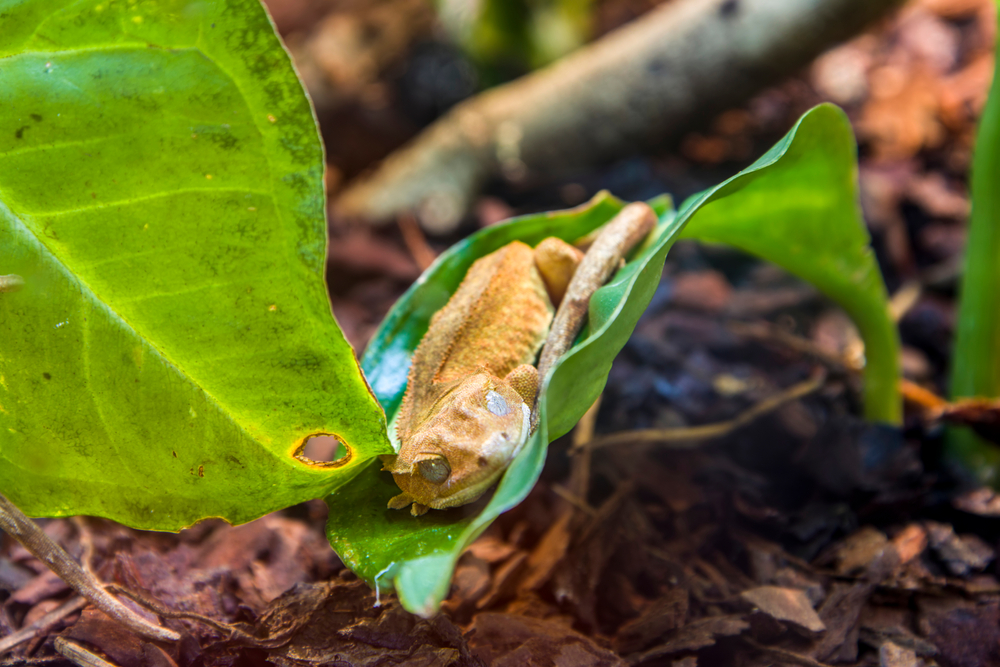
Crested geckos don't hibernate in the true sense of the word. Instead, they do something similar called brumation.
During brumation, the pet slows down their metabolism and bodily functions (eating, walking, climbing, pooping) to conserve energy. You might notice the pet resting for long periods in dark areas of their habitat during the colder days of the year — and that's completely normal.
What's not normal is to see no movement from your pet. Brumating crested geckos should still have some awake time each day. If you notice a lack of movement, weight loss, or a change in skin color, it's time to call the veterinarian for a consultation.
To help a pet hydrate, offer a bath in lukewarm water. You can use the same type of water you offer the pet in his drinking bowl. The water should be no deeper than his belly. During the pet's bathtime, play lifeguard and stay close by.
If wrinkly skin is a recurring issue, talk with your veterinarian to get to the root of the problem. Maybe the enclosure is too warm and dehydrating, or it may have an illness. It's also possible the reptile enclosure isn't humid enough.
Crested geckos are petite reptiles with gentle personalities. They're perfect for reptile-loving families who don't have space for a large habitat in their homes but still want to explore these unique animals. And best yet, you can get two or three cresties to live together as a happy little addition to your family!
Here's what you'll learn about crested geckos:
A Brief History and Origin of the Crested Gecko
How Long Do Crested Geckos Live?
Why Crested Geckos Make Good Pets
Setting Up the Ideal Tank for a Crested Gecko
What Do Crested Geckos Eat?
How Do I Play with a Crested Gecko?
Ongoing Care Tips for Crested Geckos
A Brief History and Origin of the Crested Gecko

Crested geckos are originally from New Caledonia, a group of tropical islands in the South Pacific Ocean off the east coast of Australia. Once assumed extinct, the geckos were rediscovered in 1994 and soon after legally exported and introduced to the pet industry. Now, you can see them up close in pet stores across the globe!
In the wild, you'll find crested geckos hanging out in short trees and bushy foliage in the forest. These nocturnal animals like to stay tucked away to camouflage into the environment as they sleep away the days and hunt for food at night. When you do see a crested gecko out and about, you'll delight in its colorful skin featuring various patterns and shades of red, browns, greens, and other earth-tone hues. Cresteds are known as "polymorphic" or have many mutations in their appearance. Bottom line: No two cresties look exactly the same.
So, why are they called crested geckos? Look closely at their heads, and you'll see two ridges, or crests, running from just behind their eyes towards their necks, where the crests merge and create a ridge down the back. This unique trait has become their clever namesake. You might also think they could be called mini-mohawk geckos, but crested sounds a bit better!
How Long Do Crested Geckos Live?

Crested geckos are hardy little reptile pets that can live up to 20 years. That's longer than the average family cat or dog, so be sure you're up for the commitment.
A crested gecko truly is a family pet where everyone in the household should understand what these little guys need to stay happy and healthy. If the gecko is your child's pet, be ready to take over the animal's care duties when the child gets involved in school activities or goes off to college.
Why Crested Geckos Make Good Pets
.jpg?h=67%25&w=100%25&hash=A76E7AF759886708D912CDB37BB30B45)
Their small size makes cresteds a top choice on many best reptile pet lists. When adults, the animal's full length (tail and all!) are a mere 8 to 10 inches. This means they are easy to handle and don't require a large habitat to be comfortable in your home.
These guys are also very docile and friendly. They're unlikely to bite unless provoked or when feeling scared. Cresties make great pets for supervised, older children and responsible teenagers who want to learn more about reptiles and see them up close.
Setting Up the Ideal Tank for a Crested Gecko

Be sure your crested gecko's habitat is set up and ready to go before you bring the pet home. We've got a few tips on choosing the tank, heating and lighting, decor, bedding, and food options.
Choosing a Habitat/Tank
If you adopt a baby crested gecko, a smaller 10-gallon tank will work just fine. However, if you bring home an adult or only want to buy one habitat your pet can grow into, look at a 20-gallon enclosure or larger. (Remember that for cresties, height is more important than ground space, so go taller rather than longer.) Be sure it has a locking screen lid because cresties are curious and will nudge at the top to climb even higher — up and out of the tank if allowed!
Check out the Zilla Tropical Vertical Kit that measures 12" x 12" x 18". Since crested geckos are arboreal (aka tree dwellers), the vertical nature of this habitat allows the pet to climb, climb, climb. Plus, there's a locking latch and locking pin on the enclosure's front door to keep your pet safe. This kit also includes lots of accessories, such as a feeding dish, coconut husk bedding to get started, and a humidity/temperature gauge.
Selecting Lighting and Heating
Crested geckos — just like all cold-blooded reptiles — need accessory lighting and heating to help replicate their native environments, regulate day/night cycles, and promote proper digestion. Browse the Zilla Habitat Guide and the new Ultimate Guide to Lighting & Heating for specific details regarding heating and lighting for a variety of reptile pets.
As you set up the crestie's tank, use heat bulbs that will keep the home's temperature around 72-75°F. Some reptile experts warn that cresties can overheat easily, and exposure to temps over 80°F for too long can be fatal. Carefully experiment with your pet to learn what temperature allows for the most activity and happiness. For a good starting point, begin with the temperature the pet was enjoying in his previous pet store home.
Unlike most reptile pets, crested geckos do not need special lighting, such as UVA or UVB bulbs. This is because they are nocturnal, and hunt and play in the dark — not light. However, you can use the Zilla Canopy Series Tropical bulb for light to see your pet at night. The UVB bulb won't hurt your crested. You can use also a blue moon LED light or night red bulb to view your crested during their active night hours.
Crested geckos are tropical and need high humidity to stay comfortable. Use a mister or humidifier to increase the moisture of the air to a minimum of 50% and a maximum of a sticky 70-80% humidity. (Note: It's OK if they dry out between mistings. Geckos don't need to be perpetually wet!)
If you keep your house cooler (in the 50s) in the winter or when you're not at home, try using a Zilla Heat Mat to add extra warmth. You could also consider the placement of the habitat. Move it to an interior room in your home, away from cold walls, drafty windows, or exterior doors.
Finding Reptile Decor

It might be tempting to buy your crested gecko a same-species friend, the ultimate in decor! This is a great idea as long as you only have one male gecko in the bunch to reduce the chances of fighting. You can easily tell if a crested is male or female by looking at its underside. A male has two bulges under the skin at the base of the tail. This area is flat and smooth on females.
The more friends you add, the bigger your tank should be so they all have enough room to spread out and play. For example, a tank with two crested geckos should measure at least 23" x 16" x 15".
Pro Tip: Never mix various reptile species in one tank. This can trigger fighting and injuries.
Beyond friends, deck the tank out with ample tree branches and foliage to replicate the tree environment these cuties love to explore. Choose store-bought branches of varying widths to exercise the gecko's grip. Use a variety of faux plants with various leaf shapes and sizes to nudge and poke around. These features will keep the pet entertained!
Pro Tip: It's best if you leave those branches from your last hike in the forest, no matter how cool they look. You might accidentally introduce parasites or creepy crawlies into the habitat that could make your crested sick.
Cresties also like to have a few hiding spots in their home. These places keep them cool and allow some private rest time. Pick out a Bark Bends log or driftwood with a hole bored in it to serve as a little hideaway den.
Using Bedding/Substrate
On the bottom of your crested gecko's tank, you'll want a little something to absorb waste and odors. Plus, it can amplify the look of the forest-themed tank. We call this bedding or substrate.
For tropical geckos, consider Zilla Bark Blend, Coconut Husk, or Jungle Mix. These most closely replicate the animal's natural native forest environment. You can review the Zilla Bedding Guide for more ideas too.
The Terrarium Liners from Zilla also work great for crested geckos. It's a no-pile carpet that's easily cut to fit the bottom of the enclosure. It's treated with a biodegradable enzyme that helps keep odors to a minimum. Simply wash, dry, and reuse the liner when it's time to clean your pet's home. (You can also use plain paper towels, which are easy to replace.)
Cleaning the Tank

Plan to tidy up your crested gecko's tank each day. This means picking up obvious waste or uneaten food to keep the home from getting stinky. You can use a scoop to keep this task super easy.
Deep clean the enclosure every two or three months to make sure the walls sparkle so you can easily see your dino buddy:
Step 1: Remove your pet.
This is a good time for the pet to enjoy playtime with a family member or friend. Or, the pet can hang out in a large Zilla Micro Habitat to stay safe. Be sure to use the locking mechanism at the top if you don't want to go on a gecko hunt later.
Step 2: Turn off and unplug the lighting fixture.
Unplug any heat mats or other warming elements. Set them aside to cool off on a durable surface, such as a tile floor or stone countertop.
Step 3: Remove all decor.
Place the decor in a sink filled with hot water and a squirt of dish soap. Use a scrub brush to clean the items. Then, rinse the decor in a sink filled with a 10% bleach water solution. That's about 1 cup of bleach for a half-filled average-size sink basin. Rinse the decor with clear water and allow it to dry on a towel.
Step 4: Remove the bedding from the habitat.
Use the Zilla Corner Scoop to remove the bedding and place the soiled bedding in the waste can or compost bin. If you use a substrate liner, wash it with the decor in the step above.
Step 5: Wipe down the empty habitat.
Use a sponge soaked with hot water and dish soap. Be sure to remove lingering debris in the corners and stuck to the walls of the tank. Then, rinse with clean water using a sprayer attachment on your sink or a clean sponge. Finally, towel dry the habitat or allow it to air dry.
Step 6: Clean the habitat.
Once the clean habitat is dry, use the Zilla Terrarium Cleaner. This spray will add shine to the glass or acrylic surfaces, deodorize the habitat, and create an anti-static barrier to reduce dust build-up from the bedding. Simply spray on the clear surfaces of the habitat, then wipe off using a soft towel. Place the habitat back where it usually sits.
Step 7: Add new bedding and arrange the freshened decor.
This is your chance to mix things up and place the climbing branches and foliage in new positions for your pet to explore. Think of it like rearranging a kid's bedroom to add new interest and excitement.
Step 8: Replace the lighting fixture and any heating elements.
Plug them in and let the home get warm before you put your pet back inside. This may take up to 20 minutes or so. Use a digital thermometer to test the tank temperature and ensure it's ready for your tiny dino.
Step 9: Return your crested gecko back to his habitat.
Enjoy watching him explore his clean home. And don't forget to lock the enclosure, so your pet doesn't wander away to climb the curtains!
What Do Crested Geckos Eat?

In the wild, crested geckos spend their evenings hunting for rotting fruits and unsuspecting insects to create a balanced diet.
When kept as pets, these omnivores enjoy eating live crickets no larger than the distance between the pet's nose to eye. This helps prevent choking. To boost the nutritional value of live foods, offer the insects Zilla Gut Load Cricket Drink before feeding your crested gecko. Then, at mealtime, spray the insects with Zilla Vitamin Supplement to aid calcium metabolism and Calcium Supplement to support bone health.
In addition to insects, serve up a commercially prepared crested gecko diet balanced with essential proteins, vitamins, and minerals. Try the Gecko Gold Powdered Diet featuring banana, apple, and mango. It easily mixes with water to form a soft mash your gecko will lick up with delight.
If you want to work on bonding with your pet, offer a hand-fed snack, like a peeled extra-ripe banana. We dare you not to giggle at the gecko's pink tongue tasting the sweet fruit!
Plan to feed your pet a meal two to three times each week or approximately every other day. (And don't forget to clean out uneaten food no more than 24 hours later.)
What Do Crested Geckos Drink?

Crested geckos need access to fresh water at all times. Fill a shallow terrarium dish and mist water around the habitat once a day.
What's the best water to use? Choose ionized micro-clustered water filled with antioxidants and minerals poured from a water ionizer attached to your tap. Or, you can use tap water filtered through charcoal to remove the chlorine.
Avoid reverse osmosis water or distilled water since the beneficial mineral content is removed.
Check out the Zilla Feeding Guide for more information on feeding reptile pets.
How Do I Play with a Crested Gecko?

When handling your crested gecko, sit down and get cozy. It's best to have a soft touch and move slowly with a crestie. Let them crawl on your hands or up your sleeve to your shoulder.
You can create a game of hand-over-hand, also known as "hand walking," letting them run from one palm to your other palm. Then, line the first hand up again, palm to palm, so they can keep exploring. Just remember to move slowly.
If crested geckos feel spooked or threatened, they will detach their tail (called caudal autotomy) and run off. This is completely normal. You may see several cresteds in a pet store without their tail! The wiggly tail acts as a distraction while the gecko escapes predators or scary situations. If your pet's tail does snap off, it will not grow back. And a vet visit isn't needed. The area will heal over quickly, and your new pet will earn the nickname "Stubby." To avoid this type of situation, move slowly around the pet and keep "predators" such as the family cat or dog away from the habitat.
Pro Tip: To reduce the risk of spreading illness, wash your hands before and after handling any pet, including a crested gecko.
Ongoing Care Tips for Crested Geckos

Crested geckos require daily care to stay healthy. This includes taking note of any physical changes or shifts in behavior that may indicate illness or disease, assisting with shedding, and allowing the pet to bathe as needed. Keeping a journal (major inspo here) regarding your pet's weight, feeding habits, and general health is not only a good way to bond with extra interactions, but also ensures your crested stays in tip-top shape. As you care for your crested gecko, never hesitate to call your exotics veterinarian with questions.
Common Issues
One of the common issues you may see in your crestie is in their mouth. Pay attention to the membranes around the mouth. If they become red or inflamed, contact your veterinarian for treatment options.
It's important to keep the humidity and temperature levels consistent to help maintain easy breathing for your pet in the terrarium. If you notice your lizard isn't breathing normally, contact your veterinarian.
Crested geckos may also experience problems with shedding, dehydration, parasitic infections, and skin rashes. These are all easily treated by a veterinarian.
Shedding
Crested geckos will shed their skin periodically as they grow. Sometimes called molting or sloughing, this is natural and healthy for them. Think of it like buying your growing toddler a new set of pajamas when they've outgrown the old pair. The shedding process also eliminates any parasites hanging out on the gecko's skin.
Baby crested geckos will usually shed weekly. As they get older, shedding decreases to every two weeks. Expect to see a shed every few weeks to every month when they're adults.
When a crested gecko is about to shed, the old skin will appear tight and duller in color. Then it will turn white and flake away, sometimes in large patches. Shedding happens fast. When the crestie outgrows the skin, it will loosen and peel or flake away in about 20 minutes. The pet generally doesn't need any help with shedding (although a light water mist might be appreciated); you will notice the pet rubbing against the branches in the habitat to help loosen the dead skin.
Pet owners often wake up to a fresh, brighter-colored pet after a nighttime molting session. And if you notice the pet is sporting fresh skin, but the shed skin is missing, reptiles have a yucky (but safe!) habit of... eating the old skin, so predators don't know they are in the area.
Hibernation/Brumation

Crested geckos don't hibernate in the true sense of the word. Instead, they do something similar called brumation.
During brumation, the pet slows down their metabolism and bodily functions (eating, walking, climbing, pooping) to conserve energy. You might notice the pet resting for long periods in dark areas of their habitat during the colder days of the year — and that's completely normal.
What's not normal is to see no movement from your pet. Brumating crested geckos should still have some awake time each day. If you notice a lack of movement, weight loss, or a change in skin color, it's time to call the veterinarian for a consultation.
Bath time
Crested geckos with wrinkly skin are likely dehydrated and need a bath. Healthy skin appears firm and smooth. Geckos not showing signs of dehydration can skip bath time.To help a pet hydrate, offer a bath in lukewarm water. You can use the same type of water you offer the pet in his drinking bowl. The water should be no deeper than his belly. During the pet's bathtime, play lifeguard and stay close by.
If wrinkly skin is a recurring issue, talk with your veterinarian to get to the root of the problem. Maybe the enclosure is too warm and dehydrating, or it may have an illness. It's also possible the reptile enclosure isn't humid enough.
Crested geckos are petite reptiles with gentle personalities. They're perfect for reptile-loving families who don't have space for a large habitat in their homes but still want to explore these unique animals. And best yet, you can get two or three cresties to live together as a happy little addition to your family!
